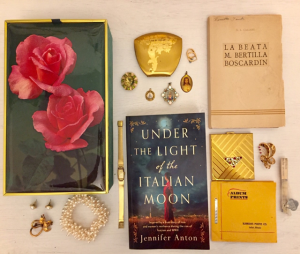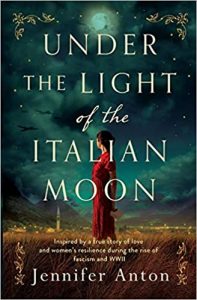What Women Leave Behind: The Journey of Writing Under the Light of the Italian Moon
What Women Leave Behind:
The Journey of Writing Under the Light of the Italian Moon by Jennifer Anton
 I started writing Under the Light of the Italian Moon in 2006, which became my year of coming to a new understanding of women. I was pregnant with my daughter; every part of my body was inflated and foreign to me when I attended my baby shower.
I started writing Under the Light of the Italian Moon in 2006, which became my year of coming to a new understanding of women. I was pregnant with my daughter; every part of my body was inflated and foreign to me when I attended my baby shower.
The ladies in my family surrounded me in blessings while my Italian grandmother sat to the side, a quiet spectator. That night, she called an ambulance and never left the hospital. Two months later, I had my daughter via an emergency c-section and then went into heart failure, causing me to have to leave my baby at home with my mom.
My milk came in and soaked my dressing gown while the doctors tried to save my malfunctioning heart. I recovered—but my grandmother did not. She died, never getting to meet my daughter. I wondered what of hers I could give to my child to make sure she was remembered.
A notebook on my counter held questions I had intended to ask my grandmother about her childhood in Italy and during WWII. Instead, I filled pages with her eulogy, written as a letter to my daughter to introduce her to her great grandmother. At the wake, my mom, who never speaks in public, stood up with a stronger voice than I had ever heard her use, and spoke about her mother. It was an epiphany moment for me. Mothers, daughters, grandmothers—our connection flashed in front of me, as boldly as sunlight in my eyes.
There began the fourteen-year journey of researching and writing my first novel. The questions had to be answered. The stories had to be told. I was the only one to do it. Like raising a second child, I gave writing and researching my early mornings, late nights, vacations and weekends. I visited my grandmother’s sister with my tape recorder and notepad, documenting stories. I called cousins in Canada who had grown up in Fonzaso with my grandmother, asked them questions and listened. I took my first writing course under Jerry Cleaver at Chicago’s famous, The Writer’s Loft. I wrote, researched and wrote some more.
But you can’t write a novel about Italy without truly understanding the country. So, I applied for my Italian citizenship and travelled to meet family in Fonzaso and Serena del Grappa. I hired translators and consumed large amounts of coffee, polenta, eggplant parmigiana, prosecco, biscotti, wine and grappa while sitting across from elderly relatives.
Their eyes glistened as they answered my questions—going back, remembering. Looking at them, I did not see age spots and grey hair; I saw them as they were in my book, when Mussolini implemented his egotistical plan and Nazi’s occupied their town. I shook my head time and again at their stories, the atrocities they witnessed but never mentioned, until you asked.
After years of repeating this process, I had a manuscript. A jumble of stories, facts, and emotions. Somewhere underneath, there was a love story and a tale of women’s resilience, but it was buried below piles of words, years of writing. Each new year I set a goal of finishing the novel, but the clutter of it overwhelmed me. My busy career allowed me little progress on the book. By this time, I had moved to Italy and then London. I took more writing courses and joined the London Writer’s Club for inspiration.
Then, two books released which helped me visualise my path forward: The Tattooist of Auschwitz by Heather Morris and Beneath a Scarlet Sky by Mark Sullivan. In reading these novels, both biographical fiction, I finally found books like mine—examples of how real people’s lives could mingle with fiction to tell stories that needed to be remembered. I saw a genre and a future for my book.
From there, I worked with the best editors I could find, starting with Sally Orson-Jones, who works with Sarah Waters. Sally was the first person to read my full manuscript, and her feedback gave me clear direction on the main thing I had to do–scrape away the superfluous to find the heart of the book. Sally’s feedback was instrumental to helping me develop something I considered a novel.
But after my edits, it was still not exactly there. The second half felt engorged with facts. I hired Angela Meyer, who had edited The Tattooist of Auschwitz and Cilka’s Journey. Her feedback addressed the character arc of my protagonist, Nina, and the development needed to cleanly portray her changes. With that feedback, I finished the novel feeling that I had nailed it—I had finally said what I wanted to say. I finally had brought the story to life.
It took me fourteen years to write my novel. I know Under the Light of the Italian Moon would not be what it is if it had taken any less time. Over these years, I have watched my mother grow into her role as nonna. I have watched my baby girl grow into a teenager. Writing about Nina and her mother, the love story and lives of Nina and Pietro has been in parallel to my growing as a woman, mother and wife. I am more certain than ever that the strength of the world is in its women—that the path forward is through aspiring to love.
The book is done, to be published, fittingly, on International Women’s Day. The questions are answered and I know my grandmother helped make it happen. She is in heaven, smiling and knowing she never left me.
—
 Jennifer Anton is an American/Italian dual citizen born in Joliet, Illinois and now lives between London and Lake Como, Italy. A proud advocate for women’s rights and equality, she hopes to rescue women’s stories from history, starting with her Italian family.
Jennifer Anton is an American/Italian dual citizen born in Joliet, Illinois and now lives between London and Lake Como, Italy. A proud advocate for women’s rights and equality, she hopes to rescue women’s stories from history, starting with her Italian family.In 2012, she moved with her family to Milan, Italy and Chicago Parent Magazine published her article, It’s In the Journey, chronicling the benefits of traveling the world with children. Later, she moved to London where she has held leadership positions in brand marketing with companies including ABInbev, Revlon, Shiseido, and Tory Burch.
Jennifer is a graduate of Illinois State University where she was a Chi Omega and holds a master’s degree from DePaul University in Chicago.
Under the Light of the Italian Moon is her first novel, based on the lives of her Italian grandmother and great grandmothers during the rise of fascism and World War II.
Connect with Jennifer on Instagram www.instagram.com/
Connect with Jennifer on Facebook www.facebook.com/
Join her mailing list at www.boldwomanwriting.com
Under the Light of the Italian Moon: Inspired by a true story of love and women’s resilience during the rise of fascism and WWII
 A promise keeps them apart until WWII threatens to destroy their love forever
A promise keeps them apart until WWII threatens to destroy their love forever
Fonzaso Italy, between two wars
Nina Argenta doesn’t want the traditional life of a rural Italian woman. The daughter of a strong-willed midwife, she is determined to define her own destiny. But when her brother emigrates to America, she promises her mother to never leave.
When childhood friend Pietro Pante briefly returns to their mountain town, passion between them ignites while Mussolini forces political tensions to rise. Just as their romance deepens, Pietro must leave again for work in the coal mines of America. Nina is torn between joining him and her commitment to Italy and her mother.
As Mussolini’s fascists throw the country into chaos and Hitler’s Nazis terrorise their town, each day becomes a struggle to survive greater atrocities. A future with Pietro seems impossible when they lose contact and Nina’s dreams of a life together are threatened by Nazi occupation and an enemy she must face alone…
A gripping historical fiction novel, based on a true story and heartbreaking real events.
Spanning over two decades, Under the Light of the Italian Moon is an epic, emotional and triumphant tale of one woman’s incredible resilience during the rise of fascism and Italy’s collapse into WWII.
‘An enthralling, richly crafted story of bold women resisting destruction, death and fascism.’
– Robin Pickering-Iazzi, Professor of Italian and Comparative Literature, University of Wisconsin-Milwaukee
Amazon: www.getbook.at/Janton
BarnesandNoble: https://bit.
Category: Contemporary Women Writers, How To and Tips
























